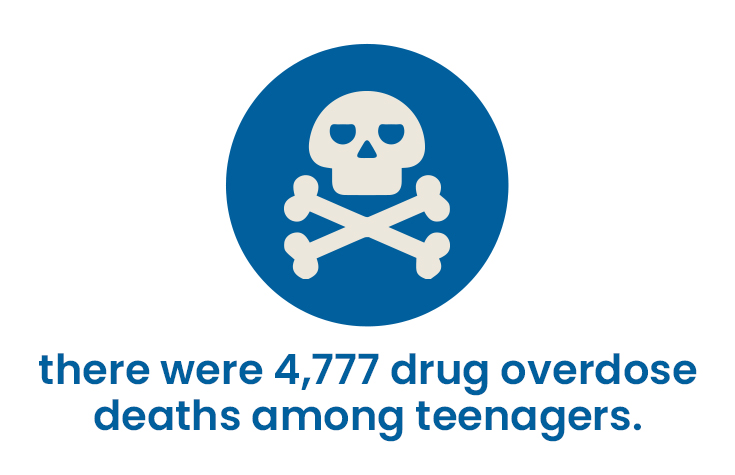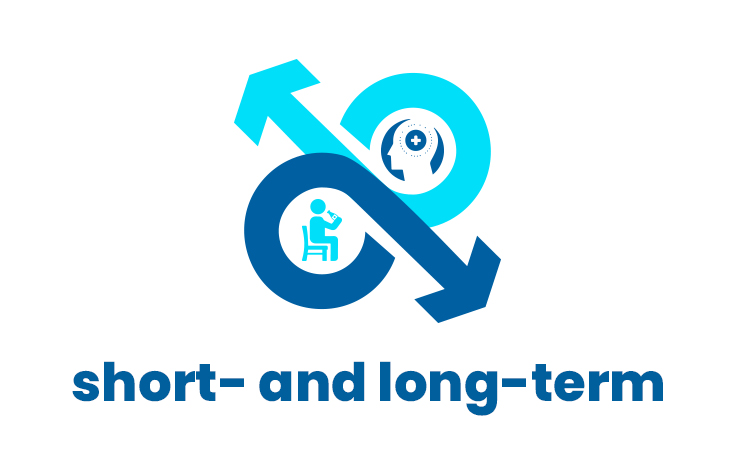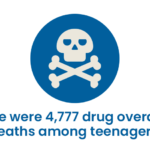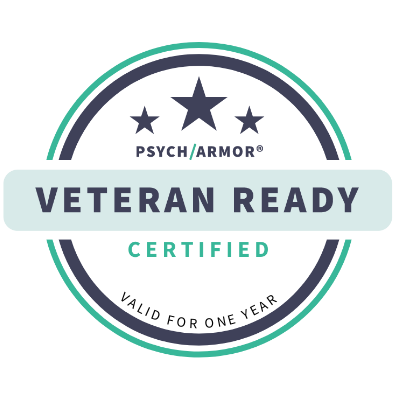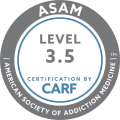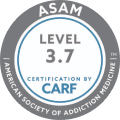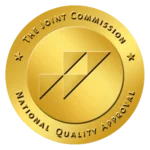America is being pummeled by drug overdose deaths. Virtually every drug you can think of is killing people, but opioids are leading the way for addicts. Since the year 2000, the number of deaths caused by overdoses has increased by eight times. Every year since 2014, record numbers of overdose deaths have occurred. Let’s put this more plainly. More people are dying from drugs in the US than ever before, and it’s getting worse every year.
In 2016, approximately 63,600 American people died from drug overdoses. Dear reader, that is over seven people every hour. Around two-thirds of these deaths were caused by opioids, killing five an hour themselves. The epidemic is real. The American life expectancy dropped in both 2015 and in 2016. Over those two years it fell from 78.9 to 78.6 which to most may seem trivial, but it is not.
Robert Anderson, chief of the mortality statistics branch at the National Center for Health Statistics, said to NPR in December of last year, “I’m not prone to dramatic statements, but I think we should be really alarmed. The drug overdose problem is a public health problem, and it needs to be addressed. We need to get a handle on it.” The last time life expectancy dropped in the US was at the peak of the American AIDS epidemic in 1993.
Is Addiction a Disease?
If you told someone all of the statistics above but did not mention that it involved drug overdoses, chances are someone would think you were talking about a disease. With such high death tolls, one would likely think it to be a horrible disease, a plague of sorts. So what does America think about drug addiction? Do we consider it to be a disease? Or do we consider it to be the result of a chosen lifestyle?
Last year, NORC at the University of Chicago, (NORC standing for National Opinion Research Center), conducted an extensive study regarding the American standpoint on drug addiction. The results show that as a country, we are coming along in recognizing addiction as a disease.
Let’s make our standpoint very clear. Drug addiction is a disease of the brain, and it is curable. Using a drug for the first few times; that is a choice. When the drug takes over your thoughts and actions only to reduce your quality of life at the cost of abusing it… that is a disease. The majority of medical professionals and authority figures consider addiction a disease. So does the National Institute on Drug Abuse, the foremost federal agency in charge of studying drug use and addiction, as well as the American Medical Association.
So does the average American agree? As you’ll see, the concern for the well-being of addicts is high, but you might be a little shocked when you discover how many people actually think addiction is a disease. Let’s take an in-depth look at the NORC study, which gives us a glimpse of where the nation stands on drug addiction – something that now kills more Americans than car accidents.
The NORC Study
Due to the survey nature of the study, what you’re about to read is mostly statistical. During reading these numbers, try not to lose sight of how serious the subject matter is. Drug overdoses kill more US citizens than nearly anything else. Everything that follows was taken from the NORC study, linked above.
More Americans recognized opioid abuse to be a community issue last year than in 2016. Last year, 43% of Americans said that prescription drug abuse was a serious problem in their community, up ten percent from two years ago. A total of 37% considered heroin to be a community problem last year, up five percent from two years ago. As far as within the home, “a majority of Americans” reported abusing substances, and 13% said someone close to them died from drug overdose. From two years ago to last year, ER visits due to drug overdose increased by an astonishing thirty percent.
Now for the big one. According to the study, 53% of Americans see prescription drug addiction as a disease. For heroin, the percentage drops significantly to about 24% which is incredible. Perhaps it is the legality of prescription pills that causes this drop. Around 44% said that heroin addiction is a result of low willpower or lack of discipline. Another 32% said it is a result of bad parenting. Less than 20% of Americans said they would refuse to ‘associate closely’ with an opioid addict “as a friend, colleague, or neighbor.” Is opioid addiction the new leprosy?
Social media tends to serve as today’s great communicator. The NORC study addressed this online world as well, finding that among those surveyed who actively use Facebook, a surprising 41% have seen posts mentioning the drug overdose epidemic. Users of Twitter, Instagram and Snapchat also reported having seen the epidemic mentioned, but in fewer numbers.
So it’s clear the public is aware of the problem. It’s also clear that the public is on the fence about whether or not addiction is a disease. The good news is that over the last few years, public opinion seems to be swaying toward believing addiction is indeed a disease of the brain. The bad news is, well, just about everything else. Deaths are on the rise. This could be why the opinion is changing. It’s getting closer to home.
The Reality
It must be easier to blame addiction on lack of willpower when addiction hasn’t directly affected you. Become misfortunate enough to have it affect you and your opinion might change. America is quite familiar with drug addiction in general. It’s in our songs, movies, newspapers, websites, books, blogs and streets. Take a look at the graphic below, borrowed from the NORC study. Drug addiction is no longer an issue that can hide in the shadows.
Regardless of the level of familiarity, and regardless of whether or not the American public considers addiction a disease, one very crucial thing is true. America definitely wants a stronger response to the epidemic.
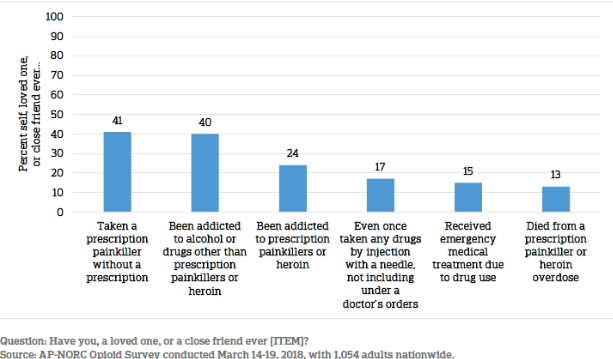
More Needs to be Done
Consider this statement taken from the NORC study. “Two-thirds say their community is not doing enough to make substance use programs more affordable and accessible, or to find ways to improve treatment for substance use.” Our only question is what the other third thinks. Yes, there are countless organizations and community action groups that are dedicated to fighting the epidemic, some with great success. We advocate such action. However, it’s deathly obvious (pun intended) that not enough is being done.
Interestingly enough, while 66% agreed that not enough is being done, only 58% said there needs to be “a lessening in the stigma of drug addiction.” Still, this is well over half of our country that thinks addicts need to stop being viewed as outcasts, according to the NORC which claims an error rate of only +/- 4.1 percent.
Perhaps most interesting in this realm of the study is the fact that viewing addiction as a disease seems to be directly related to thinking not enough is being done. Consider the following from the study:
“Those who see addiction as a medical problem are especially likely to say their community is not doing enough to find ways to improve treatment compared with those who don’t (73 percent vs. 59 percent) or to reduce the stigma toward those with an opioid addiction (66 percent vs. 52 percent).”
Know your Opioids
Okay so we’ve covered the latest available information on where America stands on the drug overdose epidemic. We went over just how big of a problem overdose really is. We pointed out how opioids are the bulk of the problem. Now it’s time to focus on the opioids themselves. There are prescription opioids and illegal opioids, and all of them have great potential to be deadly. What follows is a comprehensive list of the most abused opioids in America – and their deadly impacts.
| OPIOID | LEGAL USE | DAMAGE DONE |
| Codeine | Moderate to severe pain | See below. |
| Fentanyl | Severe pain only | ≈ 19,000 annual deaths |
| Hydrocodone | Moderate to severe pain | See below. |
| Hydromorphone | Moderate to severe pain | See below. |
| Meperidine | Moderate to severe pain | See below. |
| Methadone | Opioid addiction treatment | ≈ 5,000 annual deaths |
| Morphine | Severe pain only | See below. |
| Oxycodone | Moderate to severe pain | See below. |
| Heroin | ILLEGAL | ≈ 15,500 annual deaths |
| Opium | ILLEGAL | ≈ 330 annual deaths |
Regarding both morphine and the five opioids mentioned that are used for moderate to severe pain, no figures exist. This is because no federal agency reports individual death counts for these six substances in particular. However, using a little bit of math and a lot of critical thinking, we have come up with the following information.
Of these six legal opioids, two are much more frequently involved in fatal overdoses: oxycodone and hydrocodone. This is just something to bear in mind. Now for the math. A total of about 63,600 died from overdoses two years ago. Two-thirds of them, a total of 42,400 were from opioids, legal or not. Subtracting the fatal overdoses from fentanyl, methadone, heroin and opium, we are left with a total of about 2,600 deaths per year caused by these six unaccounted-for opioids.
In comparison to other drugs’ death figures, this might not seem like much, but consider the fact that we are talking about legal drugs for moderate pain. These are the types of pills in your parents’ and grandparents’ cabinets. To put it another way, when combined, the total number of annual US deaths caused by codeine, hydrocodone, hydromorphone, meperidine, morphine and oxycodone just about equals the total number of annual US deaths caused by fires.
In Conclusion
Addiction is a disease of the brain. Once addiction sets in, changes occur in the brain which makes the addict require more and more, despite negative consequences and regardless of the substance addicted to. Someone could be addicted to heroin, cocaine, alcohol, marijuana, cigarettes, sex, gambling, food, or even to some of the bizarre things you’ve likely seen on programs such as My Strange Addiction.
It all boils down to brain changes.
Once someone becomes an addict, the brain functions abnormally, in a way that requires the constant presence of whichever substance is at hand in order for the addict to feel normal. Of course there is much more to individual addictions than this, but an unhealthy brain is the common denominator.
Oftentimes people say that relapse is proof of addiction being the result of either a choice or poor willpower. Yet people with diseases such as diabetes or even cancer will tend to become better and then relapse as well. Obviously it’s not the exact same thing, but the logic goes to show that a recovering addict relapsing is more likely a disease symptom than a choice.
Think about it.
Fictional Tommy is a recovering heroin addict who has been clean for 9 months. Fictional Tommy was an everyday user for years, but an otherwise good guy. He lost his girlfriend, his apartment, his car, and most of his dignity to heroin. Fictional Tommy relapses one particularly hard night and uses again. He falls back into a using pattern and it starts all over again. Do you honestly think Fictional Tommy, the truly decent human being inside him, chose for this happen?
The bottom line is that more people in America need to realize that drug addiction is not just a disease, it’s a plague of sorts, and it’s killing people left and right via overdose. Most that perish this way are under 40 years old. Plenty is being done, but more needs to be. It begins with you.
If you or someone you know is struggling with an addiction of any kind, please reach out for help today. Tomorrow may be too late.


